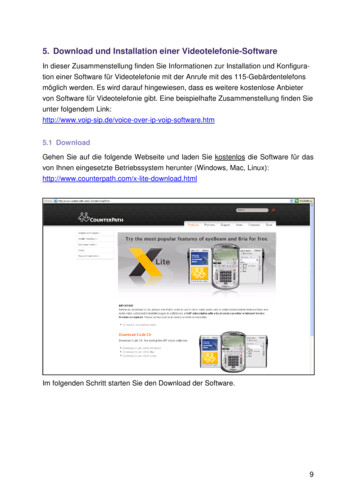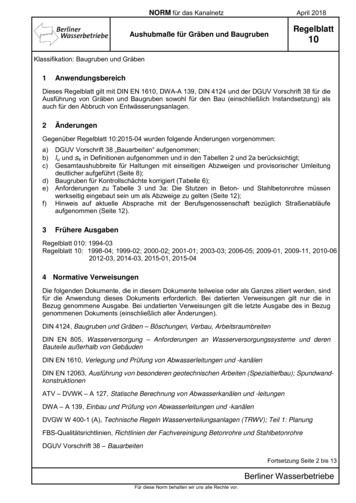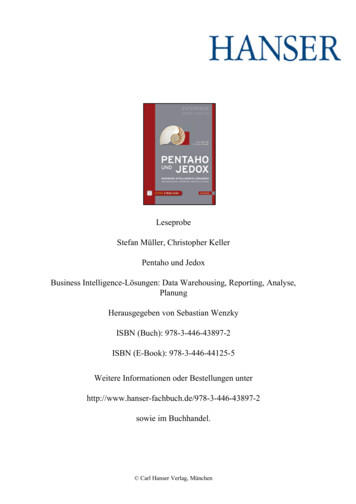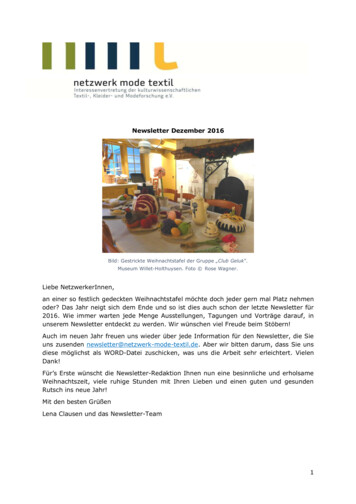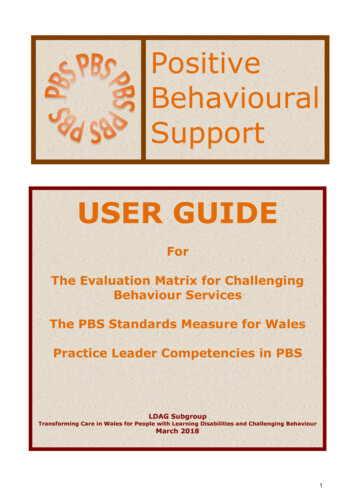
Transcription
PositiveBehaviouralSupportUSER GUIDEForThe Evaluation Matrix for ChallengingBehaviour ServicesThe PBS Standards Measure for WalesPractice Leader Competencies in PBSLDAG SubgroupTransforming Care in Wales for People with Learning Disabilities and Challenging BehaviourMarch 20181
Using this GuideThis guide has been designed for assessors who use the Evaluation Matrix forChallenging Behaviour Services, the PBS Standards Wales Measure and thePractice Leader Competencies Assessment.It contains instructions on how to use all three measures and it includescomprehensive Appendices that provide clear examples of the types ofevidence assessors will need to identify in order to complete the scales.It is important that this Guide is available to all assessors and that theybecome familiar with its contents.This Guide was developed by members of theAll Wales Challenging Behaviour Community of Practice and the LDAGSubGroup “Transforming Care in Wales for People with LearningDisabilities and Challenging Behaviour’:Professor Kathy Lowe, Dr Edwin Jones, Dr Sarah Hawkins, Wendy James,Wendy Williams (ABMU Health Board)Louise Albert, Nick Haake (National Autistic Society)Lisa Morgan (Dimensions)Sharon Donovan (Perthyn)Rhian Jones, Mark Slater (Drive)Claire Pritchard (Care Management Group)Keith Jones (Fieldbay)Tina Donovan, Richard Tiplady (Newbridges)Jonathan Crabb (BCU Health Board)Tina Hawkins (Walsingham)Simon Clarke, Paul Copp (Elliotshill)Diane Jones (Community Lives Consortium)Jim Crowe (Learning Disability Wales)Gareth Matthews, Claire Dunkerton (Mirus)Sue Jones, Adrian Roper, Hilary Jones (Cartrefi Cymru)Debbie Edwards (Carmarthen County Council)Nicola Watts, Margaret Dixon (Bridgend County Council)2
3
CONTENTSPAGEINTRODUCTION4STATEMENT OF PRINCIPLE4ABOUT THE EVALUATION MATRIX5ABOUT THE PBS STANDARDS MEASURE5ABOUT THE PRACTICE LEADERS COMEPETNCIES ASSESSMENTHOW TO USE THE THREE TOOLS6APPENDICES111. What a good Functional Assessment should include122. What a good Behavioural Assessment Report should contain133. What a good Positive Behavioural Support (PBS) Plan should contain144. Goodness of Fit Checklist 155. PBS Plan Checklist166. Positive Monitoring177. Periodic Service Review188. The Three-Stage training Model (Verbal, Role Play and In Situ)199. Interactive Training Observation Sheet2010. Social Validity Tests: ‘In their Shoes” and “Sainsbury’s”2111. Functional Assessment Measures (ABS, ABC, BBAT, FAI, MAS, CAI)2212. PCP Thinking Tools2513. Benchmarking results – Evaluation Matrix3114. Benchmarking results – PBS Standards Measure374
INTRODUCTIONPOSITIVE BEHAVIOUR SUPPORT (PBS) is the best current evidence-based practice insupporting people with learning disabilities and challenging behaviour. It is a comprehensiveterm that covers a wide range of approaches. Its origins are in Normalisation (or Social RoleValorisation), Applied Behaviour Analysis and Person-Centred Planning. PBS can be seen as atoolkit for behaviour change that is based on contemporary service values.STATEMENT OF PRINCIPLEAny specialist service for people with learning disability and challenging behaviour alsoshould be underpinned by the following key characteristics of Positive BehaviouralSupport (PBS): It is values ledIt focuses on quality of life gainsIt is inclusiveIt is based on functional analysisIt has a systems focusIt emphasises ecological andantecedent interventionIt is concerned with enhancingcompetence and teaching new skillsIt is constructional anddevelopmental Reduction in challenging behaviour is aside effect of intervention It is proactive and enables people todevelop more appropriate behaviours It has a long-term focus It involves multi-component intervention It avoids the use of punitive approaches It distinguishes between proactive andreactive approaches It involves stakeholdersAny service for people with learning disability and challenging behaviour should also: contain clear guidelines on service user capacity, consent and decision making, in linewith current legal requirements and government policy, in relation to specificassessment and intervention for challenging behaviour, i.e. conducting functionalanalysis, developing PBS plans and use of reactive strategies, etc.; adapt physical environments to the needs of the service users residing in them; be integrated within a wider multi-disciplinary system in which service users can accessclinical and therapeutic input from specialist health professionals in the CommunitySupport Team (CST) including: psychiatrists, learning disability nurses, occupationaltherapistsandphysiotherapists.ABOUT THE MEASURES5
All three measures were developed in response to stated service need expressed by providers,commissioners and clinicians working to improve the overall quality of service delivery in linewith Positive Behavioural Support (PBS) as the most effective, evidence-based, contemporarybest practice. They were developed, piloted, refined and benchmarked between 2007 and2017. This pack of measures and supporting documents represents the final version, authoredby members of the All Wales Community of Practice and the Learning Disability AdvisoryGroup, and endorsed by the Welsh Government.The measures are complementary to one another but all three can be used independently.Each of has an accompanying Evidence Template to facilitate gathering the necessarydocumentation. This separate User Guide supports the administration of all three measures.This Guide also includes a substantial set of Appendices that give detailed examples of goodpractice related to the measures. Assessors need to refer to these Appendices to ensureconsistent interpretation of evidence,The measures have been designed as service development tools, in that each generates anoverall rating or score as well as an action plan to highlight specific areas for furtherimprovement. Repeated administrations can help to track and demonstrate whereimprovements have been achieved. A brief description of each measure is given below,followed by guidance that applies to all three measures.Evaluation MatrixThe Evaluation Matrix was designed for individual service settings to assess the extent towhich they have the necessary infrastructure to be able to deliver high quality PositiveBehaviour Support. It measures capacity not performance: that is, high quality infrastructuredoes not guarantee high quality provision. It may be used by commissioners to assess thepotential suitability of services prior to purchase, and by providers for self-evaluation andservice development.The Matrix focuses exclusively on 5 sets of standards for services for people with learningdisabilities and challenging behaviour, that is: standards that are over and above therequirements for non-specialist services. Therefore, to avoid duplication with other monitoringor inspection systems, aspects to do with generic service quality are not included as it isassumed that the service being assessed meets the National Minimum Standards forDomiciliary Care Agencies in Wales: these standards are referred to briefly where relevantunder each of the Matrix headings. If the service does not fully meet the minimumstandards, then that section of the Matrix should not be scored.It is also assumed that the service being assessed upholds the following values that underpingood quality, contemporary learning disability services: The setting has a clear statement on its values base, making direct reference toNormalisation or Social Role Valorisation (SRV), or O’Brien’s Service Accomplishments(Community presence, Competence, Choice, Participation, and Respect).The Values statement indicates a person-centred, proactive focus, promotion of selfadvocacy, citizen advocacy, and access to mainstream services.The values base is a main focus of staff orientation & induction to service.THE PBS Standards MeasureFollowing the successful implementation of the Evaluation Matrix, providers identified the needfor a complementary tool that assesses the quality of service delivery to individuals. This ledto the development of the PBS Standards Measure that is designed to be administered forindividual service users. It comprises a set of 14 PBS Standards that are mapped directly tothe nine Wellbeing Outcomes in the National Outcomes Framework 2014. All items are ratedon the basis of clear evidence and scored on a four-point scale. The higher the score, thehigher the quality of PBS provision. Benchmark scores for this measure are provided in theAppendix for reference.6
Practice Leader CompetenciesA key factor in providing high quality provision is Practice Leadership. This measure focuseson the Competencies required to achieve the outcomes outlined in the PBS Standards ofWales measure. There are 15 competencies, 14 of which are mapped against the PBSStandards. Again, all are rated on the basis of evidence and scored on a four-point scale.A key purpose of this measure is to aid the development of practice leaders within anorganisation. Used in this way, administration of the measure doesn’t have to be rigid, but canbe a more organic process integrated with management or clinical supervision. Observationscan be naturalistic so the assessor can gain a realistic perspective of practice in-situ. There isno set time scale for completion of the measure as some evidence may take a while to collectand may not be an everyday occurrence. The measure is also flexible and can be used in partsonly to reflect the style or requirements of the service provided.A key requirement is for the assessor to be confident and competent in practice so they canact as Practice Leader/Coach/Mentor for the Practice leader in training. The assessor shoulddiscuss the evidence and scoring with the practice lead being assessed for each section, andgive positive and constructive feedback. Peer review using this measure may also be apositive way to support development.This measure can be complementary to other management training and assessment.Duplication with generic management skills has been avoided where possible so that the focusof this tool is on the competencies required to manage and lead the PBS approach.HOW TO USE THE THREE TOOLSWho should administer the Tools?Assessors need to have a detailed knowledge of PBS, ideally in terms of clinical intervention,direct support or management. Suitable assessors are those who have a considerable amountof experience in PBS and/or hold a specialist PBS qualification, such as: the BTEC Professional Diploma/Certificate in Positive Behavioural Support (Level 4 or 5) orsimilarthe Post Graduate Diploma in Positive Approaches to Challenging Behaviour (CardiffUniversity/University of Wales College of Medicine) or similarIdeally, the assessor should be external to the setting being assessed. However, even ifemployed within the same organisation, the assessor should not normally be assessing theirown place of work or a staff member they have direct management responsibility for.However, the Practice Leader Competencies Assessment may be used by line managers as adevelopmental tool for staff in training as Practice Leaders.How many assessors should there be?One assessor per setting is acceptable, providing they have access to the necessaryinformation. However, when used internally, it is best for more than one person to completethe assessment, to avoid bias. Some organisations find it helpful to have one external and oneinternal assessor working together: this has the benefit of providing an objective perspectiveas well as facilitating access to the necessary evidence.7
What documents are included in this suite of tools?1. This User Guide – that describes the background and structure of the tools, outlines how touse them and provides an explanation of some of the key terms and processes in a series ofAppendices, to which assessors should refer to ensure consistency in interpretation.2. The Evaluation Matrix – for assessing one service setting.This contains a set of standards in 5 separate domains, a Score Sheet, Summary of Findings,a section where descriptions of the setting being assessed and the assessor can be recorded,and an Action Plan.3. The PBS Standards Measure – for assessing service delivery to one individualThis contains a series of Performance Indicators under fourteen Standards that are mapped tothe Health and Social Care Wellbeing Outcomes, a Score Sheet and an Action Plan.4. The Practice Leader Competencies Assessment – for assessing one Practice Leader.This contains a series of Performance Criteria under fifteen Standards, fourteen of which arealso mapped to the Health and Social Care Wellbeing Outcomes, a Score Sheet and an ActionPlan.5. Three Evidence Templates [one for each tool] - for assessors’ use in collecting and trackingevidence, and keeping notes.How to gather and rate the evidenceAssessors should gather information from a variety of sources, including staff at differentlevels. This is because different parts of any organisation are likely to represent differentperspectives. For example, senior managers may be aware of certain key policies, while directcare staff, who hold responsible for implementing them, may not, thereby questioning thevalue of these policies. Broadening the sources of information is likely to provide a richer andmore considered picture.EACH STANDARD MUST BE RATED ON THE BASIS OF EVIDENCE. The type of evidencerequired is noted in each section: this can include documents or records, direct contact withstaff to find out their views or understanding of particular issues, and direct observation ofpractice. Service settings may find it useful to use the templates to compile files of evidencefor the different sections: these can then be updated on an ongoing basis to aid internal orexternal evaluation.Assessors need to consider the evidence carefully and objectively and also need to keep aclear record of what evidence was used to arrive at each rating. Space is provided on theScore Sheet for assessors to give a brief account of how the evidence was gathered.In brief, the steps are:1. Work through the Evidence Template, collecting the relevant evidence indicated foreach standard.2. Pay attention to the type of evidence to look for.3. Refer to the Appendix in this User Guide for sample documents and descriptions ofspecialist processes to help identify the correct evidence.4. File or carefully reference the evidence in the relevant section in the Evidence template.5. Once all the evidence is collected, the measure itself can be completed.6. Systematically compare the evidence against each of the standards in all five sectionsof the Matrix or fourteen PBS standards or fifteen PL Competencies, as appropriate.7. Make sure the evidence is valid – i.e. documents, records or direct feedback from staffassessors have talked to (not third party reports).8. Check that the evidence matches the types of evidence suggested in the measures.9. Use the check boxes/ratings to keep a clear record of which standards are met/and towhat degree.10. Based on the available evidence, rate each section on the Score Sheet and make a briefnote of the supporting evidence used to arrive at that rating.8
Note: In the Evaluation Matrix, the rating hierarchy of GOOD, VERY GOOD, and EXCELLENT iscumulative: To be rated GOOD, the service must achieve fully ALL the standards in the GOODcolumn for that section.To be rated VERY GOOD, the service must achieve fully ALL the standards in theGOOD column plus ALL the standards in the VERY GOOD column for that section.To be rated EXCELLENT, the service must achieve fully ALL the standards in the GOODand VERY GOOD columns plus ALL the standards in the EXCELLENT column for thatsection.NB. It is likely that many services will achieve a mixture of GOOD, VERY GOOD and, possibly,even some EXCELLENT ratings in some sections. However, it is important that the aboveconventions are adhered to for the overall rating.If any service does not achieve all the GOOD standards in a section, then that section mustnot be rated. If a service achieves all the GOOD standards, with some VERY GOOD, thatsection should be rated GOOD, even if some of the EXCELLENT standards are attained, and soon.NB. The PBS Standards measure and the Practice Leader Competencies Assessmentinclude no overall rating for each standard, requiring only total and percentagescores, plus an overall score for the whole measure.What the ratings meanThis Matrix is designed to assess a service’s capacity to provide specialist challengingbehaviour support, by considering its organisational structures and systems. The Matrix doesnot aim to reflect actual outcomes.It is important to emphasise that none of the ratings reflects a poor quality service. Only thosecharacteristics associated with good quality support for people with learning disabilities andchallenging behaviour have been included. Therefore, for a setting to rate at all on this Matrixmeans that it possesses some of the aspects of current best practice.Comparison with the general standard of services currently being provided for people withchallenging behaviour is important for meaningful interpretation of results. The benchmarkinganalysis undertaken in 2013 revealed the percentage of settings currently meeting eachstandard. These results are given in Appendix 10, while the following descriptors are given asa general guide: GOOD:This represents a good quality of service for people with challengingbehaviour. It demonstrates an understanding of the complexity of support required andshows that the service has put much effort into developing a comprehensive approachto training, assessment, staff and service user support. A GOOD rating on alldomains would indicate a sound, reliable service for people with challengingbehaviour. VERY GOOD: This rating shows that the service is above average in its achievementof standards related to challenging behaviour. It demonstrates a more sophisticatedunderstanding of current issues to do with specialist challenging behaviour services andan awareness of best practice concerns. Few services are likely to rate at the VERYGOOD level on all aspects. EXCELLENT: This rating shows that the service is of an exemplary standard. For eachdomain, an EXCELLENT rating demonstrates the highest level awareness of evidencebased practice, with complex and advanced systems in place to sustain this level ofachievement. Few services are likely to attain an EXCELLENT rating on any ofthe domains.9
The scores on the PBS Standards Measure and the Practice Leader Competencies canbe compared with the benchmarked scores provided in this User GUIDE. It isimportant to note that both these measures also represent aspirational standardsand so top scores should not be expected across the board.The Measures as Developmental ToolsOne of the key functions of these measures is to act as developmental tools to promoteservice improvement. At the end of each tool there is space for assessors to summarise theirfindings and list recommendations. These can form the basis of an Action Plan for futuredevelopment. The measures can then be re-administered after a suitable time period to assesswhether any improvement plan has achieved the desired changes.NB. It is important to keep in mind that the Evaluation Matrix is intended to assess thecapacity of a service to provide high quality support for people with challenging behaviour. Itis not designed to assess actual service user outcomes. Even if a service is rated EXCELLENTon most standards, it may not support every person with challenging behaviour successfully.Other issues, such as compatibility, may be key factors. Assessors need to keep this issue inmind at all times when assessing the service: the ratings are based on organisationsstructures and systems, and not on individual outcomes.In contrast to this the PBS Standards Measure is designed for administration with individualservice users, and focuses on actual outcomes achieved. In order to judge the success of aservice setting, all or a representative sample of service users should be assessed.10
APPENDICESAppendices 1 – 11 are given to help assessors make informed judgements about the evidencemade available to them when evaluating a service setting or outcomes for individuals. Theexamples and descriptions given in these Appendices are not intended to be prescriptive, butprovide samples of the type of documents and systems required, to help guide assessors indeciding whether the available evidence satisfies the specified standards.Appendices 12 and 13 contain the results of the benchmarking exercises that were conducted toprovide some normative data on the both measures. Appendix 12 shows each standard in theEvaluation Matrix and the percentage of settings evaluated during the pilot phases that met eachstandard. The Tables also show the percentage of settings that achieved GOOD, VERY GOODand EXCELLENT ratings on each of the 5 sections of the Matrix. Appendix 13 shows the averagescores achieved on each of the fourteen PBS standards and across the PBS Standards Measureas a whole.11
Appendix 1: What a good Functional Assessment should includeFor relatively simple or less severe challenging behaviours, a brief behavioural assessment may beappropriate. This can be conducted by asking people who know the person well to: identify the challenging behaviourdescribe how often it occurs, how long it lasts and the risks it posesidentify the time of day that it is most likely to occuridentify common predictors and setting eventsidentify common consequencesHowever, there are three indicators that point to the need to conduct a comprehensive functionalanalysis: the challenging behaviour persists despite the consistent implementation of plans based onsimpler analysesthe behaviour poses a high level of riskmore intrusive or aversive interventions are being suggestedThere are three main elements to the process of conducting a comprehensive functional analysis:1. Data collectionThere are three main ways of collecting information for a functional analysis. These are:a) by interview, using a range of structured measures (eg the Functional Assessment Interview(FAI), the Motivational Assessment Scale (MAS), the Contextual Assessment Inventory (CAI), mentalhealth assessments, skills assessment and so on)b) by direct, naturalistic observation (using ABC charts or other behavioural monitoring forms,scatterplots and so on)c) by direct observation under specific conditions (analogue assessments – these are rarely neededand would have to be done only by trained professionals under carefully controlled conditions).A comprehensive functional assessment should always include a) and b) above2. FormulationThis involves knitting together different information streams into a coherent single picture of whybehaviours are occurring. This is a complex skill. It involves checking out whether different ways ofasking the same question produce the same answer (a process sometimes called triangulation), thatall key information has been included, and seeing whether the overall picture described makes sensefrom a theoretical and practical perspective3. Summary statementsThese are the outcome of formulation. They provide a brief overall hypothesis as to the keyconditions that are influencing behaviour. As well as providing shorthand accounts of the results ofthe assessment, they provide the basis for planning interventions to help reduce challengingbehaviour. They, therefore, provide the direction for intervention. Summary statements are organic,and may change as more assessment data become available or as feedback from interventionsbecomes available.12
Appendix 2: What a good Behavioural Assessment Report should containA Behavioural Assessment Report is intended to communicate the findings of the functionalassessment for a specific service user. It is designed to be read quickly and accurately and will beread by professionals, a person’s carers (including both paid and family carers) and the person at thecentre of the report themselves wherever possible (producing user friendly versions will often benecessary for this reason).The report must be accurate, data-based and respectful. The latter is particularly important: peoplewith challenging behaviour will often have extremely negative images and reputations and anassessment report can serve either to perpetuate such images or to paint an alternative picturedepending on how it is written. While individual reports will necessarily vary, the best BehaviourAssessment Reports will conform to the following content criteria.PresentationTitle pagePersonal historyCurrent servicesHealth andmedical needsStrengths andneedsShort sentences used wherever possible, avoiding unnecessary jargon and withtechnical terms explained clearly.Clear headings used throughout, any graphs or tables clearly labelled. Anyassessment tools used are specified.Well presented and generally error free (e.g. spell checked etc)Including an indication that the report is private and confidential, the serviceuser’s name, date of birth, current address, the names of those people whocontributed to the report, and the date it was produced.A brief account of key events in the person’s life, emphasising a positive imageof the personA brief description of where the person currently lives and any other servicesthat they receive, with an indication of the levels of support provided withinthese servicesA statement of any significant health needs that the person has (and, whererelevant, a description of how these might impact upon their behaviour), plus adescription of any physical treatments that the person may be receiving(including psychotropic medications) or an indication of where these arerecordedA description of the person’s skills and abilities, plus any identified skilldeficiencies (and, where relevant, a description of how these might impact upontheir behaviour)MotivationalanalysisA statement of all the person’s preferred reinforcersBehaviours ofconcernA clear description of what each behaviour of concern looks like, and anindication of the known frequency, intensity and duration of each behaviourEarly indicatorsA clear description of the early signs that the person is becoming agitated andthat challenging behaviour may be about to occurRisk factorsA statement of known personal risk factors and known environmental riskfactors that the person has been exposed toSlow triggersA clear description of identified slow triggers that is derived from detailedassessment and triangulation for each behaviour of concernFast triggersA clear description of identified fast triggers that is derived from detailedassessment and triangulation for each behaviour of concernMaintainingreinforcersA clear description of identified reinforcers that is derived from detailedassessment and triangulation for each behaviour of concernSummarystatement(s)A simple summary statement and/or a contingency diagram, based on aformulation of the assessment dataMediator analysisA summary of the strengths and needs of the mediators (that is, the planimplementers i.e. direct carers).13
Appendix 3: What a good Positive Behavioural Support Plan should containComplex challenging behaviours require support plans that cover all areas of need. The purpose of aPBS plan is to provide the key information that staff require to provide consistent support to aservice user on a daily basis. The plan should be written in a clear, concise manner, avoiding the useof jargon wherever possible. It should be based on a functional analysis and focus on bringingtogether the key elements of: primary prevention; secondary prevention; reactive strategies and riskmanagement. Because a PBS plan is a summary, it can be supplemented by more detailed guidancecontained in personal files.While individual plans will necessarily vary, the best PBS plan will conform to the following contentcriteria.Identifiers and planpreparationService user penportraitBehavioural summarystatements (fromfunctional analysis)Specific health needsPrimary preventionstrategiesSecondary preventionstrategiesReactive strategiesEvaluationThis is key information about the plan, including the dates the plan waswritten, agreed with the service user, implemented and due for review.Review dates should be preferably 3-monthly, but at least annual. Planwriters' names and plan aims should also be included.This is a brief description of the person's strengths and abilities, likes anddislikes, family contacts and other key personal contacts. The emphasisshould be on positive characteristics (challenging behaviours should bedescribed in the next section and not here).A recent photograph may also beincluded, and dated. A clear, positive image of the person's face is required.This is taken directly from the behaviour assessment report. The following 4elements should be clearly and concisely described: 1. Each challengingbehaviour; 2. Identified slow triggers for each behaviour 3. Identified fasttriggers for each behaviour; 4. The function that each behaviour serves forthe service user (e.g escape noise; gain social contact; gain access toactivity, self-stimulation, and so on).Any health needs should be included, even if they are not directly related tothe person's challenging behaviourThese are short-term and long-term strategies that help the person behavein non-challenging ways. This should be the most substantial section in theplan. It should include information on positive interaction and communicationmethods. It should also includes strategies for: changing environmentalconditions; modifying specific triggers and skill teachingThese are behaviour management procedures to prevent full-blown episodesof challenging behaviour. They should include: information on early signsthat the person's behavi
3. The PBS Standards Measure - for assessing service delivery to one individual This contains a series of Performance Indicators under fourteen Standards that are mapped to the Health and Social Care Wellbeing Outcomes, a Score Sheet and an Action Plan. 4. The Practice Leader Competencies Assessment - for assessing one Practice Leader.
